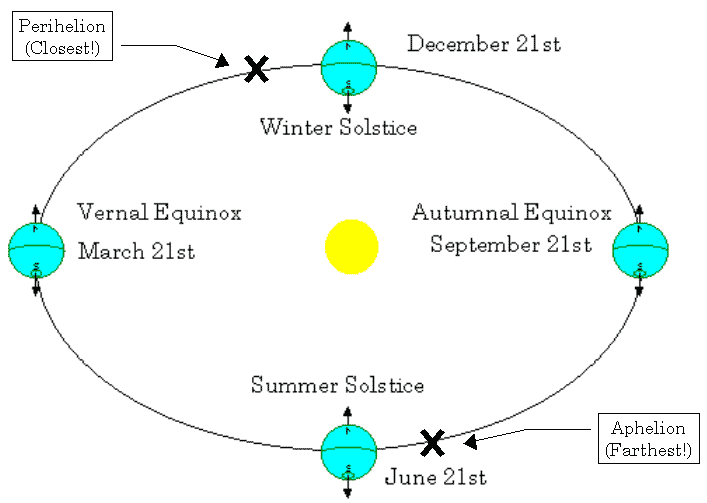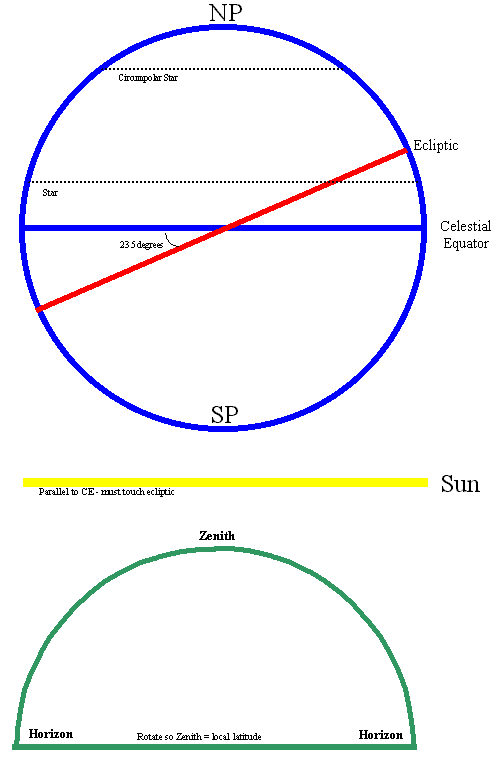Seasons on Earth
Earth's Tilt
The fact that we have seasons (Spring Summer Fall Winter) on
Earth is entirely due to the tilt of our North-South axis (by 23.5 degrees)
relative to the orbit of the Earth around the Sun. This axis essentially
remains fixed in space relative to the outside stars (thus it points very
nearly to Polaris .. the North Star). Depending on where the Earth is in the
orbit .. a given hemisphere will "see" the Sun as higher in the sky
or lower in the sky. When the Sun is high in the sky, the weather is warmer ...
summer! When the Sun is low in the sky, it is colder .. winter! (The reason for
the seasons is often misunderstood to be the fact that the Earth is a little
closer to the Sun part of the year, and farther away for the rest of the years.
This is wrong - the closest the Earth gets to the Sun is actually in the Winter
time .. and the farthest location is in the Summer time. Also, the difference
in distance is only a few percentage points of the average distance .. this
would not be enough to account for the large temperature changes between the
seasons!)
Diagram of the Seasons (and the Perihelion and
Aphelion)

Equinoxes and Solstices (oh my)!
During the Equinoxes, the Earth has equal day and nights.
During the Summer Solstice, the day is as long as it can get (and the night as
short). In the Winter Solstice, the day is short, and the night is long. These
are also explained by the tilt of the axis ... during the Summer Solstice, the
Northern Hemisphere faces the Sun as much as it can (bottom of the figure
above) - as it moves around the orbit to the Fall Equinox, it is not facing the
Sun as much. By the time of the Winter Solstice (since the NS pole still points
the same way relative to the outside stars) the Northern Hemisphere now only
sees the Sun in a more glancing way (it will be low in the sky).
A Hands-On model - showing Seasons and
Equinoxes/Solstices and Lunar Phases
Ingredients
- Light bulb (or some object) to be the Sun
- Mini globe (or full size one) of the Earth
- Small ball for the Moon (KMart sells a small half
black/half yellow ball that is perfect!)
- Paper signs for Polaris (put on ceiling if possible) and
Seasons with Zodiac names (put around the room)
Setting up the model
- Put the Sun in the center of the space you will use
- Put Polaris sign high on the wall, or on the ceiling if
possible - set it up so that the Earth at the Spring location would point its
North pole to Polaris
- Designate 4 points around a circle around the Sun - these
are the Season points - put the cards with the Season names and the Zodiac
names
- Summer = Aquarius, Capricornus, Sagittarius - arrow from
right to left (i.e. Sagittarius .. to Capricornus .. to Aquarius)
- Fall = Pisces, Aries, Taurus
- Winter = Leo, Cancer, Gemini
- Spring = Scorpius, Libra, Virgo
How to use the model
- Looking down from above, Earth revolves around the Sun in a
counter-clockwise manner - moves through the seasons
- North pole of the Earth should always be pointed the same
way (toward Polaris, ideally)
- As the Earth moves around the Sun - rotate the Earth on the
axis in that same sense
- Note how well the Northern Hemisphere can "see"
the Sun ... very well in Summer, not so well in Winter
- As Earth moves around the Sun, notice what the
"midnight side" of the Earth sees ... different constellations
depending on where the Earth is in the orbit
- Put the Earth in the Summer position - Northern Hemisphere
sees the Sun "high" in the sky
- Bring the Moon in orbit around the Earth - start with it
farthest from the Sun
- Notice that as the Earth rotates on the axis - the Sun is
high in the sky .. what about the Moon?
- It looks "low" in the sky, just like the Sun
appears in the winter time
- Put the Earth in the Winter position and do the same as
above (note Moon is "high" when Sun is "low")
- Use your head at a position "fixed" in its orbit,
move the Moon around your head in an orbit that has the same "sense"
as the Earth's orbit (counter-clockwise from above)
- Keep the yellow half of the moon always facing the
Sun
- Pick four locations around the orbit to "observe"
the sun (the closest to the Sun, the farthest, and either side)
- At the farthest from the Sun, we see the whole bright side
of the Moon - Full Moon! (If Moon lines up with Earth-Sun = lunar
eclipse)
- At the closest to the Sun, we see the "dark side"
of the Moon - New Moon! (If Moon lines up with Earth-Sun = Solar
eclipse)
- When "ahead" of the Full moon .. we see a
crescent - with the bright side pointing to the Sun
- Using your head as the Earth, you can rotate
(counter-clockwise from the top) and "observe" the sky changing -
have someone hold the Moon for you
- Depending on where the moon is in its phase .. does it show
up near sunset, sunrise, midnight, noon?
- New Moon - near noon, Full - near midnight, waxing (getting
more full) - sunset, waning (getting more New) - sunrise
Another Model for how our rotating Earth sees the Sun and
the Stars (and how we explain the Equinoxes and Solstices)
I will describe a hands-on demo that you can use to explain
a wide variety of effects of the Earth's rotation. The easiest way to do it is
with overhead transparency sheets. (Thanks to Michael Lopresto of HFCC for this
model!)
Ingredients :
- 1 sheet of transparency paper
- at least 4 colors of pens
- protractor (the half-circle kind - with angles on it)
Steps to create the demo:
- In Blue, draw a full circle with the protractor and put a
line for the diameter (this is the Earth and the Equator)
- Indicate the North pole and South pole locations at the top
and bottom
- In a second color (red), draw another diameter line tilted
23.5 degrees from the equator - label this the Ecliptic
- In third color (green), draw a single hemisphere (with the
diameter) - label the 90 degree mark "Zenith" and the two sides
"Horizon" - this is the "Observer" layer
- In a fourth color (yellow), draw a straight line (as wide
as the above diameter) and label it "The Sun"
- Optionally, you can add dotted lines parallel to the
Equator in the upper hemisphere of the Earth (put one near the equator .. and
one up near the pole)
- Separate all the individual pieces (leave room around them
to "grab onto")
|

Click on image for a bigger view.
|
How to use the model:
- Put the Earth layer down first .. then the Observer
layer
- Rotate the Observer layer so that the Zenith points to the
angle of the desired latitude (about 45 degrees would work for Detroit)
- Put the Sun layer parallel to the Equator - it is
constrained to move only parallel to the Equator - and it must intesect the
Ecliptic
- Start with the Sun line superimposed on the Equator .. this
could be the Spring Equinox
- Notice that the part of the Sun line that is
"above" your horizon is as long as the part that is "below"
your horizon - equal day/night!
- Move the Sun line up so that it touches the point where the
Ecliptic touches the upper hemisphere - this is the Summer Solstice
- Notice the Sun line "above" your horizon is much
larger than the one below (long day - short night)
- Move the Sun line back down to superimpose the Equator -
this is the Fall Equinox
- Move the Sun line down to the lower limit - this is the
Winter Solstice - notice the short day and long night!
- Now take a look at the two star lines .. they are parallel
to the Equator, since their motion appears based on our rotation
- The star line that is more near the Equator spends some
time above the horizon .. but sometimes is below the horizon (that star can
"set")
- Notice the star line up higher near the pole ... that star
aways stays above the horizon .. we call that a circumpolar star (never
"sets")
- For the Northern Hemisphere ... the Big Dipper is always in
the sky ... but stars that are down near the Ecliptic will set

